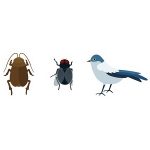Particularly active during summer months when the temperatures are warmer, stinging pests can cause major concerns for your facility operations. Stinging insect populations can grow rapidly if nests are not treated as soon as they are discovered. Hundreds of small, but ferocious pests can disrupt productivity and potentially harm employees with their painful stings.
These stings can sometimes cause more serious health issues including swelling, infections, nausea and/or allergic reactions, so it is important to stay proactive if stinging pests are reported around your facility. Here are some common stinging insects to look out for in and around food processing facilities.
- Bees: Most bees rarely sting humans. Stings normally occur when the insects are accidentally contacted by swatting them, grabbing them or finding them in an area unexpectedly. Many bees are considered beneficial and should be safely relocated by a professional when found if they are in an area with people.
- Paper Wasp: These pests may at first appear to be yellow jackets with their black bodies and yellow markings. However, they are easily identified by their signature yellow antenna. Preferring to live in dark, void areas, they can be attracted to the dimmer parts of your facility. Paper wasps will sting to protect their colony, releasing toxins that can be harmful to humans and can cause severe allergic reactions.
- Hornet: Hornets are some of the more aggressive stinging pests you’ll When perceiving threats, hornets are known to deliver painful stings or even squirt out venom that can sometimes cause temporary blindness to their victim. If you see a hornet’s nest, it is important to stay proactive and contact your pest control provider immediately for treatment and handling.
- Yellow Jacket: Known for their signature black bodies and yellow markings, yellow jackets are highly aggressive stinging insects. These pests can cause property damage to wooden surfaces and even drywall. If you see a few adult yellow jackets around your facility, there is likely a nest nearby.
- Ants: Some ant species can deliver a painful and sometimes dangerous sting. Fire ants, harvester ants and Asian needle ants for example. These are primarily outdoor ants, but they will come inside at times to look for food and water.
So, how can you help protect your food manufacturing and handling facility—and your employees—against stinging pests? By implementing an Integrated Pest Management (IPM) program.
IPM programs focus on preventive techniques like exclusion, sanitation and maintenance to keep pests where they belong—outside your business. Most food processing facilities have customized IPM programs in place, especially if they undergo regularly third-party food safety audits. These programs are implemented by qualified pest control technicians in collaboration with a facility’s food safety and quality assurance team to help deter pest activity and prevent infestations.
When it comes to stinging pests, there are a variety of techniques that can help keep these pests at bay:
- Maintain your property grounds. Beautiful blooms and elaborate landscaping make your property more attractive to employees, potential clients and flying, stinging pests alike. Trimming overgrown branches, keeping plants from touching the exterior of your building and removing excess wood mulch can help limit the presence of stinging pests.
- Secure your exterior. Perhaps the most important preventive measure you can take when it comes to helping eliminate pests inside your facility is implementing exclusion tactics. Exclusion refers to techniques that include the repairing, sealing off, and shutting down of any common entry points for pets around your facility. Make sure to inspect your exterior with your pest control provider to determine where you can continue to secure your facility.
- Keep it clean. Maintaining a clean facility cannot be overstated when it comes to helping keep any pests at bay. Make sure you clean your facilities daily, wiping down surfaces, removing clutter and emptying trash cans. Exposed trash and food debris can inadvertently attract stinging pests to your facility. Keep the exterior clean also by not allowing materials and old equipment to accumulate.
- Train your staff. Investing in a staff training plan that teaches your employees how to spot signs of stinging pests is also an effective way to help prevent an infestation on the front end. Your employees see and hear more than you might know, which makes them invaluable in helping identify pest issues. Most pest control providers offer complimentary staff training, making this tactic cost-effective for your operations. Once your staff knows the types of stinging pests that frequent your facility, persistent hot spots and the process for reporting pest activity, they’ll be able to help you address pest issues quickly and effectively.
In case of a stinging pest infestation, it is important to quickly notify your pest control provider. Keeping detailed records of where they were seen and high activity times of day can assist them in quickly diagnosing the issue and removing the threat. In cases of extreme infestation, more aggressive pest treatments such as fumigation may be necessary. For certain pests, such as honeybees that are highly beneficial to the environment, relocation/removal done by a professional is paramount. If a hive is disturbed through improper removal, it can prompt an aggressive, antagonistic and perhaps medically hazardous response from the hive. Be sure to check local regulations regarding honeybees. Many states have legal restrictions in place protecting these bees.
Now that you understand some of the types of stinging pests you may encounter and ways to help prevent and control a growing population at your facility, don’t forget to review your unique IPM plan with your pest control provider. If you don’t have an IPM program in place or a reliable pest control provider, now’s the time to implement one before it becomes a costly pest issue—or worse, brings harm to your employees and customers. Staying on top of stinging pests can help keep your product protected, employees safe and business running smoothly.







